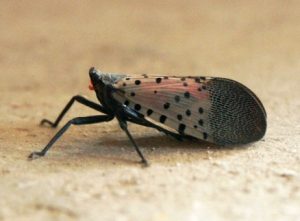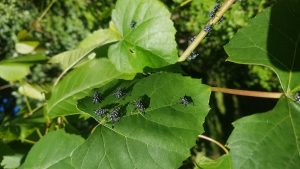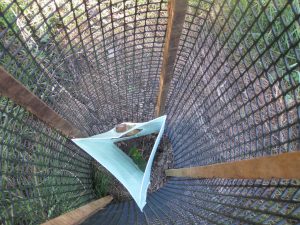 Beautiful though invasive, no one would have imagined these pretty creatures to be destructive! But the fact is they are indeed resulting in menace in areas where they are spotted.
Beautiful though invasive, no one would have imagined these pretty creatures to be destructive! But the fact is they are indeed resulting in menace in areas where they are spotted.
They call it the lantern fly!
Adult lantern flies are inconspicuous spotted, brownish-grey plant hoppers about 1″ to 1¼” long. The front wings are grey with black spots, and the hind wings are red, black, and white. The legs and head are black, and the abdomen is yellow with broad black bands. Inconspicuous, that is until they hop or take flight and show off their bright orange-red and white underwings.
The Spotted Lanternfly is native to China, India, and Vietnam, and can cause major damage to grapes, fruit trees, and other trees and shrubs in other areas, such as the U.S. First detected in the United States in Berks County, Pennsylvania in September 2014, they are spreading rapidly and present a serious threat to gardens, orchards, and woodlands.
 This insect is considered a threat to crops and many people are working to try to prevent it from spreading. Soon the females will begin to lay eggs. Each female will lay up to 100 eggs or more this fall, so by destroying even one female, you are reducing the potential population for the future.
This insect is considered a threat to crops and many people are working to try to prevent it from spreading. Soon the females will begin to lay eggs. Each female will lay up to 100 eggs or more this fall, so by destroying even one female, you are reducing the potential population for the future.
Egg masses adhere to flat surfaces, including tree bark. Freshly laid egg masses have a grey, waxy, mud-like coating, while hatched eggs look like brownish, seed-like deposits in four to seven columns about an inch long. Trees attacked by the spotted lanternfly will show a grey or black trail of sap down the trunk.
As they feed, the insects excrete a sticky substance called honeydew, which is rapidly colonized by sooty mold, turning leaves, stems, and trunks black. It also attracts ants, wasps, and other insects that feed on the sweet substance.
Their capacity to cause destruction is evident from the below news articles:
Recently spotted lanternfly has the potential for devastation
By Hilary Holladay Orange County Review Feb 4, 2018
ORANGE — Watch out for the spotted lanternfly.
That’s the word from Shawn Appling, associate extension agent for horticulture, serving Orange, Culpeper, and Madison counties. The invasive insect was spotted in Frederick County in early January, and it is the menace of potentially devastating proportions.
The red-winged, black spotted bug sucks the life out of grapevines and fruit trees and typically makes its home in the tree of heaven, an invasive tree that is all too familiar to property owners in and around Orange County.
Entomologist gives an update on potential insect pests
Feb 22, 2018, MU Extension
PALMYRA — “The genie’s out of the bottle” on the spotted lanternfly, University of Missouri Extension entomologist Kevin Rice told farmers at the second annual NEMO Soils and Crop Conference in Palmyra.
Rice gave farmers an update on insects to watch in the upcoming growing season. He urged them to contact him when they find these invasive pests so he can track their presence in the state.
Entomologists spotted the spotted lanternfly in Pennsylvania in 2014, and Virginia, Delaware and New York in January 2018. It likely is making its way to Missouri, Rice said. The plant hopper’s eggs travel on metal objects such as railroad cars, boats, and tractor-trailers. Its primary host plant is grapes, but it also affects other fruit and ornamental trees, and hops. It was observed feeding on soybean and corn in Pennsylvania in 2017. Its honeydew secretions attract other pests to feed.
Many measures are used to prevent the damage caused by the lanternfly such as the use of insecticides, herbicides, cutting down the trees infested with lanternflies etc. These all methods have proved to be ineffective.
Now, we no longer have to depend on conventional, toxic insecticides to deal with these pests!
We need a long-term and effective solution to control their nuisance. We at C Tech Corporation have a solution to combat against the lantern fly.
Combirepel™anti-insect repellent is a C Tech Corporation product which is a solution to prevent the infestation against these pesky little black flies.
Combirepel™does not kill the target species but only repels them thus balancing the ecology and thus helping in maintaining the goal of sustainability.
Our product works on the mechanism of repellency. It temporarily inhibits the mating cycle of the insects. The product impairs the ability of the insects to reproduce, that is the insects will not lay eggs or the laid eggs will be infertile. The product causes feeding disruption in an insect by triggering an unpleasant reaction within the insect which might try to feed on the application. The product temporarily blocks the reproduction system of the insects by hindering the release of the vital hormones for growth.
Combirepel™ liquid concentrate which can be diluted in paints in a specific ratio can be applied to the concrete fences around farms, homes, etc. to keep the lantern flies away.
Combirepel™ lacquer can be coated as a topical application on the surface of the wood, concrete metal etc. It can be applied on the tree trunks to keep these pests at a bay.
 Besides this, we offer Combirepel™ masterbatches that can be added to tree guards, agricultural film, pipes, even cables to protect them from the ravaging insects.
Besides this, we offer Combirepel™ masterbatches that can be added to tree guards, agricultural film, pipes, even cables to protect them from the ravaging insects.
Contact us at technical.marketing@ctechcorporation.com if you are facing problems with insects.
Also, visit our websites:
http://www.ctechcorporation.com/
http://www.rodrepel.com/
http://www.termirepel.com/
http://www.combirepel.com/
Follow our Facebook pages at:
1] https://www.facebook.com/Combirepel-411710912249274/
2] https://www.facebook.com/Termirepel-104225413091251/
3] https://www.facebook.com/Rodrepel-120734974768048/
Follow us on our Twitter pages at:
1] https://twitter.com/rodrepel
2] https://twitter.com/termirepel
3] https://twitter.com/combirepel
